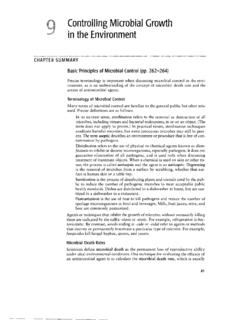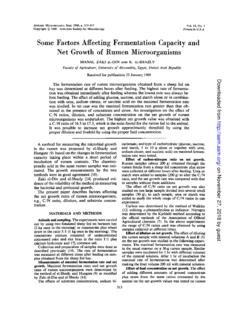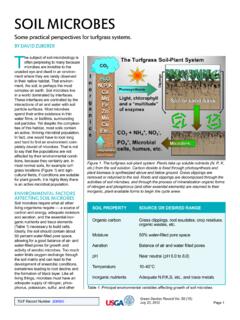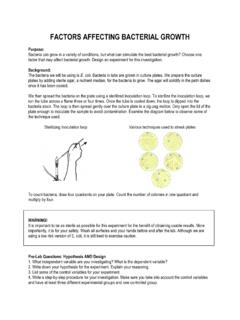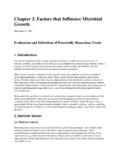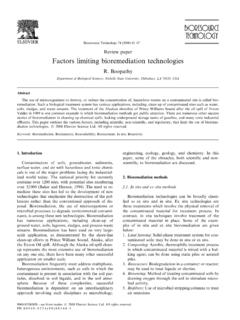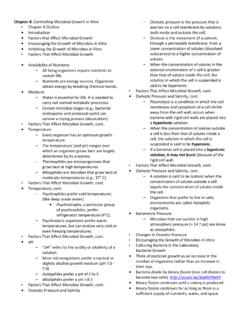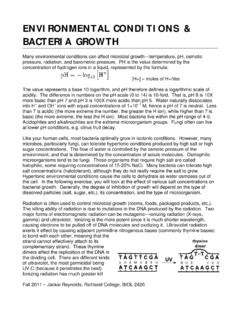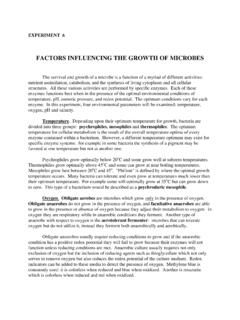Transcription of Inherent Factors Affecting Soil Respiration - USDA
1 Page 1 Guides for Educators (May 2014) soil Respiration is a measure of the carbon dioxide (CO2) released from soil . It is released as a result of decomposition of soil organic matter (SOM) and plant litter by soil microbes and through plant roots and soil fauna. It is an important indicator of soil health because it measures the level of microbial activity and the content and decomposition of SOM. It also reflects the condition of the physical and chemical environment of a soil . In the short term, a high rate of soil Respiration is not necessarily desirable; it may indicate an unstable soil system and loss of SOM from excessive tillage or other Factors . soil Respiration can be measured by simple methods or more sophisticated laboratory methods. It is an indication of the conversion of nutrients in organic matter to forms available for plant use ( , phosphate as PO4, nitrate nitrogen as NO3, and sulfate as SO4). soil : An Essential Link inthe Cycle of LifePLANTSFood + OxygenSOILW ater +CarbonDioxideSUN Figure 1.
2 microbial activity and Respiration and mineralization of organic matter in soil completes the lifecycle of earth-released water, oxidized minerals (NO3 and PO4, etc.), and CO2 needed by photosynthetic green plants to use the sun s energy to produce food (carbohydrates, etc.) and oxygen ( Doran, M. Sarrantonio, and Liebig. 1996. soil Health and Sustainability. In Advances in Agronomy. Volume 56:1-54. Academic Press). Inherent Factors Affecting soil RespirationInherent Factors such as climate and soil texture impact soil Respiration . Soils that have lower porosity also have a lower Respiration rate. soil Respiration rates are also dependent on dynamic soil Factors , including SOM content, temperature, moisture, salinity, pH, and aeration. Biological activity of soil organisms varies daily and seasonally. microbial Respiration more than doubles for every 10 C (18 F) that soil temperatures rise, to a maximum of 35 to 40 C (95 to 104 F).
3 Page 2 Guides for Educators (May 2014) soil Health Respiration usda -NRCS soil temperatures higher than these limit plant growth , microbial activity, and Respiration . soil Respiration generally increases as soil moisture increases; however, oxygen is limited when the soil pores are filled with water, interfering with the ability of soil organisms to respire (fig. 2). Ideal soil moisture content is near field capacity, or when approximately 60 percent of the pore space is filled with water. Respiration is limited in dry soils because of the lack of moisture for microbial activity and other biological activity. When water fills more than 80 percent of the pore space, soil Respiration reduces to a minimum level and most aerobic micro-organisms begin to use nitrate (NO3) instead of oxygen, resulting in loss of nitrogen as gases (N2 and nitrogen oxides), emission of potent greenhouse gases, reduction in yields, and an increased need for nitrogen (N) fertilizer, which increases cost.
4 Medium textured soils (silty and loamy soils) commonly have a favorable soil Respiration rate because they have higher porosity, good aeration, and high available water clayey soils, much of the SOM is protected from decomposition by clay particles and other aggregates that limit soil Respiration and associated mineralization (ammonification) of organic N. Sandy soils typically have a low content of SOM and low available water capacity, which limit soil Respiration and mineralization of N. Figure 2. Relative aerobic microbial activity ( Respiration , ammonification, and nitrification) and anaerobic microbial activity (denitrification) as related to water-filled pore space in soil (Linn and Doran, 1984; Parkin and others, 1996). soil Respiration Management Management practices can increase or decrease the content of SOM and the potential for compaction. soil biological activity increases with increased SOM and porosity. Increase Respiration by leaving crop residue on the soil surface, using no-till cropping systems, growing cover crops and high-residue crops, and using other practices that add organic matter to the soil .
5 Crop residue that has a low carbon-to-nitrogen (C:N) ratio ( , soybean residue) decomposes faster than residue that has a high C:N ratio ( , wheat straw). Using tillage methods that remove, bury, or burn crop residue or applying a high amount of N fertilizer stimulates microbial activity and can diminish SOM. soil compaction can be managed by reducing soil disturbance and limiting equipment use. Irrigating dry soils and draining wet soils can significantly increase soil Respiration . soil Respiration tends to be higher in the rows than between the rows because of the presence of plant roots. Compacted areas, such as wheel tracks, tend to have lower Respiration because of limited aeration and drainage and higher soil water content. Manage soils to minimize compaction and maintain high porosity. Managing soil pH and EC (salinity) is important for crop growth and the availability and distribution of nutrients, and it impacts soil organisms that decompose SOM and provide for other processes that contribute to soil Respiration .
6 Fertilizers may stimulate Respiration and root growth and nourish microbes; however, some fertilizers can be harmful to Page 3 Guides for Educators (May 2014) soil Health Respiration usda -NRCS microbes if applied in high concentrations. In addition, sludge or other organic material that has a high concentration of heavy metals, certain pesticides or fungicides, or salts may be toxic to microbes. To improve SOM content and limit compaction: Minimize soil disturbance and use of farm equipment when soils are wet. Use equipment only on designated roads or between rows. Limit the number of times equipment is used in a field. Subsoil to break up compacted layers before starting a continuous no-till system. Maintain living roots as long as practical by growing cover crops after harvesting. Apply solid manure or compost at a proper agronomic rate. Use diverse crop rotations that include high-residue crops and perennial legumes or grasses.
7 Maintain a cover on the soil and leave undisturbed residue on the soil surface rather than incorporating, burning, or removing it. soil biota respond favorably to management practices such as using plant residue, maintaining living roots, applying manure, tilling, and applying nitrogen (table 1). Certain management practices can induce a temporary increase in soil Respiration and can have a negative impact on SOM content. Table 1. Interpreting management impacts on soil Respiration and soil organic matter (SOM) Management practice Application Short-term impacts Long-term impacts Application of solid manure or organic material Apply at proper agronomic rate. Provides carbon and nitrogen to microbes, increasing their activity. Increased Respiration when manure begins to break down; increased biomass/forage production. Improved soil structure; increased fertility and SOM content. Use of high-residue crops or cover crops in rotation Crops that have a high ratio of carbon to nitrogen (C:N) produce a high amount of biomass.
8 Leave residue on soil surface to increase SOM. Temporary fixation of nitrogen during residue breakdown; increased soil moisture; decreased erosion. Improved soil quality; increased fertility and SOM content. Tillage, such as annual disking or plowing Mixes the soil , resulting in a temporary increase in oxygen and contact of residue to soil , allowing microbes to break down carbon sources. Released nitrogen and other nutrients and CO2; increased potential for erosion; increased rate of decomposition of residue and other carbon sources. Decreased SOM content, soil quality, and soil fertility; reduced diversity of soil micro-organisms (increased bacteria); damaged soil structure. Page 4 Guides for Educators (May 2014) soil Health Respiration usda -NRCS Table 1. Continued Management practice Application Short-term impacts Long-term impacts Use of crop residue Leave residue on the surface, increasing ground cover, to protect the soil .
9 Nitrogen temporarily tie d up during breakdown of residue; increased soil moisture; decreased risk of erosion; lowered soil temperature. Increased soil quality, fertility, and SOM. Application of nitrogen fertilizer or manure Provides nitrogen (energy), which allows microbes to break down residue with high C:N ratio more rapidly ( , corn stalks, wheat straw). Temporary increased Respiration due to increased rate of organic material breakdown. If properly managed, increased SOM and soil quality; increased production and residue. Use of farm equipment or other vehicles Compacts soil , decreasing pore space, water movement, and oxygen and increasing nitrogen loss from denitrification. Decreased Respiration , yields, and water infiltration; increased runoff. Decreased production; increased risk of erosion and runoff; decreased soil quality and microbial activity. What management practices are used on the fields being evaluated, and what impact will these practices have on Respiration ?
10 _____ _____ _____ Will the management practices have a positive or negative impact on soil organic matter content and porosity? Why or why not? _____ _____ _____ Page 5 Guides for Educators (May 2014) soil Health Respiration usda -NRCS Problems Related to soil Respiration and Relationship to soil FunctionSoil Respiration reflects the capacity of soil to sustain plant growth and soil microbes. It is an indication of the level of microbial activity, SOM, plant litter, and decomposition. soil Respiration rates can be used to estimate nutrient cycling in the soil and the ability of the soil to sustain plant growth and biological activity. Excessive Respiration from decomposition of plant litter and SOM commonly occurs after tillage due to increased soil aeration. A low soil Respiration rate indicates limited availability of SOM or plant litter for soil microbes. It may also signify soil conditions (temperature, moisture, aeration, porosity, and available N) that limit biological activity and decomposition.










